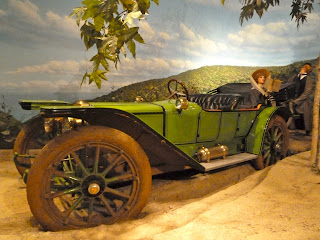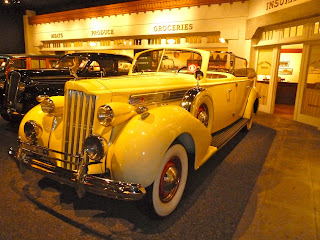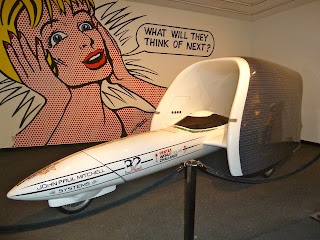 |
| An exhibit outside the Los Angeles Museum of Art. It represents every type of street lamp found throughout the city. They remind me of street lights from long ago. |
Southern California has a warm climate with sunny days most of the year. According to my guide, 75% of the time the temperature is between 70 and 80. In the summer it is hotter, and there are a few cooler days in the winter. After the cold days in Santa Fe where the temperature was in the 20s, I found the mid-60s temperatures of LA to be delightful. But, I had to laugh. The locals were bundled up as if it were freezing, some with down coats and wooly hats. A bus driver told me it was so cold he had to put on his “long johns” that morning. Here I was walking around in short sleeves with no jacket. I suppose it was not surprising that I received a few incredulous stares.
Petersen Automotive Museum
 |
| Have you ever seen a Mack Truck like this one? |
I got my first car when I was 18. It was a 1955 Nash Rambler, a junk heap, but it represented freedom. I could now go where I wanted without having to check bus schedules or depend on someone else to drive me. I had somewhat of a love affair with cars when I was a little kid. I loved the big old behemoths of the 1950s with their huge fins. When I was very young, my parents had an old Pontiac station wagon that had a wooden body. These cars became popular with California surfers in the 1960s and were called woodies. Sometimes grass seeds would get into the cracks of the wood and after it rained the seeds would sprout. The car looked rather funny with grass growing out of the sides. Walking around Los Angeles, I passed a museum devoted to cars, both old and new, and I decided to check it out. After all, it might have a real woody inside.
 |
| I did find a woodie. This one is a 1939 Pontiac. Have you ever seen one on the road? I like the thick white sidewall tires. The front of the car--the hood and fenders--are made of steel but the side body is make of wood. |
The Petersen Automotive Museum sits on Wilshire Boulevard along Miracle Mile in Los Angeles. Robert Petersen, founder of Hot Rod and Motor Trends magazines, established the museum with his wife in 1994. On display are about 100 vehicles ranging in age from the earliest automobiles to a brand new Bugatti. The museum owns another 100 vehicles that are not on display. All of the cars and trucks in the museum are fully functioning. Many of them are driven or shown at car shows. Below are pictures of a few of the cars on display.
 |
| Some early cars had wheels with wooden spokes. |
 |
| I like the streamlined body on this old race car. |
 |
| Where's the steering wheel? This very early car used a tiller instead. |
 |
| In its day, this car was pure luxury. It is a 1911 American Underslung Model 50 Traveler. |
 |
| How would you like to race this 1955 Cobra? |
 |
| Built for speed this is a 1959 Ol' Yaller Mark III |
 |
| Doesn't this car look elegant? Right behind the door, there is another small side door that opens to a compartment where you can store your golf clubs. In 1930, Nash made and sold this car to affluent drivers. |
 |
| Where's the radiator? This car was way ahead of its time. It is a 1917 Detroit Electric Brougham Model 61. Marketed to ladies, the seats allowed passengers to face each other for conversation. |
 |
| If I could have taken any car home with me, it would have been this 1939 Packard Super Eight Phaeton. |
 |
| Engines have evolved over time. This 2007 Honda Indy V-8 engine was designed for race cars. |
 |
| What WILL they think of next? Actually, this Mana La Solar Vehicle dates back to 1988. |
 |
| As I left the Peterson Automotive Museum, I saw two city blocks filled with trucks serving restaurant food. These "meals on wheels" arrive and set up just in time for lunch before moving to a different location. |
Griffith Observatory
If you go to Los Angeles, you might consider a trip to the Griffith Observatory. Perched high on a hill above the city, you can learn a lot about astronomy and the universe while exploring the many exhibits. From the terrace, you also will find a breathtaking view of the city below and a fairly close-up view of the Hollywood sign.
In the late 1800s, Colonel Griffith J. Griffith donated more than 3,000 acres of land to the City of Los Angeles. He also left money in his will for the construction of an observatory, a planetarium, and an exhibit hall. It was not until the 1930s that the observatory was built. It opened in 1935 and quickly became a favorite spot for visitors. Two powerful telescopes afford astronomers opportunities to view the night skies and all that they have to offer.
 |
| From the observatory's terrace, you can almost see the mountains in the background. They are obscured by a thick layer of yellow smog created by the exhaust from gasoline-powered engines. |
 |
| The Griffith Observatory. Each dome on the left and right contain powerful telescopes. The dome in the center contains the planetarium, and the exhibit halls are in the flat-roofed sections of the building. |
 |
| This is what part of Los Angeles looks like from the Griffith Observatory. Why do you think the picture is not clearer? What is causing the haze? |



















No comments:
Post a Comment